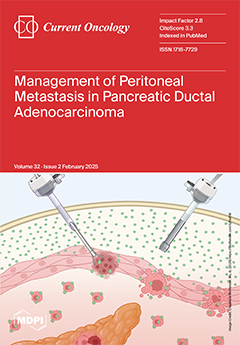Recently, homologous recombination deficiency (HRD) has become a new target for hereditary cancers. Molecular-based approaches for hereditary cancers in the clinical setting have been reviewed. In particular, the efficacy of the
PARP inhibitor has been considered by several clinical trials for various kinds
[...] Read more.
Recently, homologous recombination deficiency (HRD) has become a new target for hereditary cancers. Molecular-based approaches for hereditary cancers in the clinical setting have been reviewed. In particular, the efficacy of the
PARP inhibitor has been considered by several clinical trials for various kinds of hereditary cancers. This indicates that the
PARP inhibitor can be effective for any kind of
BRCA mutated cancers, regardless of the organ-specific cancer. Homologous recombination deficiency (HRD) has become a new target for hereditary cancers, indicating the necessity to confirm the status of HRD-related genes.
ARID1A,
ATM,
ATRX,
PALB2,
BARD1,
RAD51C and
CHEK2 are known as HRD-related genes for which simultaneous examination as part of panel testing is more suitable. Both surgical and medical oncologists should learn the basis of genetics including HRD. An understanding of the basic mechanism of homologous repair recombination (HRR) in
BRCA-related breast cancer is mandatory for all surgical or medical oncologists because
PARP inhibitors may be effective for these cancers and a specific strategy of screening for non-cancers exists. The clinical behavior of each gene should be clarified based on a large-scale database in the future, or, in other words, on real-world data. Firstly, HRD-related genes should be examined when the hereditary nature of a cancer is placed in doubt after an examination of the relevant family history. Alternatively, HRD score examination is a solution by which to identify HRD-related genes at the first step. If lifetime risk is estimated at over 20%, an annual breast MRI is necessary for high-risk screening. However, there are limited data to show its benefit compared with
BRCA. Therefore, a large-scale database, including clinical information and a long-term follow-up should be established, after which a periodical assessment is mandatory. The clinical behavior of each gene should be clarified based on a large-scale database, or, in other words, real-world data.
Full article






